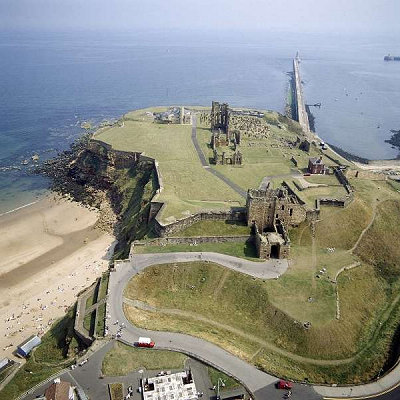
Like us on Facebook
PLACE NAMES


 
|
|
Tynemouth
|
 |
| |
The headland towering over the mouth of the Tyne has been settled since the Iron Age. The Romans occupied it. In the 7th century a monastery was built there and later fortified. The headland was known as PEN BAL CRAG.
The place where now stands the Monastery of Tynemouth was anciently called by the Saxons Benebalcrag—Leland at the time of Henry VIII. The monastery was sacked by the Danes in 800, rebuilt, destroyed again in 875 but by 1083 was again operational.
Three kings are reputed to be have been buried within - Oswin - King of Deira (651); Osred II - King of Northumbria (792) and Malcolm III- King of Scotland (1093). Three crowns still adorn the North Tyneside coat of arms. (North Tyneside Council 1990).
The queens of Edward I and Edward II stayed in the Priory and Castle while their husbands were campaigning in Scotland. King Edward III considered it to be one of the strongest castles in the Northern Marches. After Bannockburn in 1314, Edward II fled from Tynemouth by ship.
A village had long been established in the shelter of the fortified Priory and around 1325 the then Prior built a port for fishing and trading. This led to a dispute between Tynemouth and the more powerful Newcastle over shipping rights on the Tyne which continued for centuries. (For more history see North Shields).
In the late 18th century, sea-bathing became fashionable in Tynemouth. King Edward's Bay and Tynemouth Longsands are very popular with locals and tourists alike. Tynemouth is also a surfing championship venue
The Land of Green Ginger on Front Street is a haven of niche shops run by independent retailers housed in the former 19th century Congregational Church (1868 by Thomas Oliver; hall dated 1886 in door lintel). Although converted to retail in 1980, it still retains many original features, including stained glass windows, arches, high ceiling beams and a Commemorative Plaque in recognition of the Volunteers and Reservists from Tynemouth who fought in the Boer War.
Opposite is a statue of Queen Victoria by Alfred Turner, unveiled on 25th October, 1902. This is situated at the edge of the Village Green which is home to the War Memorials for the residents of Tynemouth lost during the Second Boer War of 1899-1902. Designed by A.B. Plummer, it was unveiled on the 13th October 1903 by William Brodrick.
The larger central memorial is made of white granite with a cruciform column rising from between four struts in a contemporary design for its time. The front face has a relief sword and wreath carved onto it with the inscription below. The other three faces hold the honour roll for those lost during both World Wars. It was unveiled in 1920 and the designer is unknown.
Just off the main road, on Huntington Terrace, is The King's School a private co-educational day school. Adjacent to the school is Tynemouth Metro station, originally opened in 1882 as a mainline station catering for the thousands of holiday-makers who flocked to the Tynemouth beaches. Its ornate Victorian ironwork canopies have earned it Grade II listed status.
Wide view of Tynemouth pier and lighthouse, with the town behindThis massive stone breakwater extends from the foot of the Priory some 1000 yards out to sea, protecting the northern flank of the mouth of the Tyne. It has a broad walkway on top, popular with Sunday strollers. On the lee side is a lower level rail track, formerly used by trains and cranes for loading ships. At the seaward end is a light-house. The pier's construction took over 40 years (1854-1895). In 1898 the original curved design proved inadequate against a great storm and the centre section was destroyed. The pier was rebuilt in a straighter line and completed in 1909. A companion pier at South Shields protects the southern flank of the river mouth.
This small beach within the mouth of the Tyne, sheltered between the Priory and the Spanish Battery, was popular with Victorian bathers and is now home to the local sailing club.
This headland dominates the river mouth. It takes its name from the Spanish mercenaries who manned guns there in the 16th century to defend against invasion. It continued to be used in this way into the 20th century. It's now a popular vantage point for watching traffic on the Tyne.
Beyond the Battery and commanding the attention of all shipping on the Tyne is the giant memorial to Lord Collingwood, Nelson's second-in-command at Trafalgar, who completed the victory after Nelson was killed. Erected in 1845, the monument was designed by John Dobson and the statue was sculpted by John Gordon Lough. The figure is some 23ft tall and stands on a massive base incorporating a flight of steps flanked by four cannons from The Royal Sovereign - Collingwood's ship at Trafalgar.
These rocks in the Tyne near the Monument are covered at high water and over the centuries have claimed many ships who "switched off" after safely negotiating the river entrance. In 1864, the Middens claimed 5 ships in 3 days with many deaths, although the wrecks were only a few yards from the shore.
|
 Feel free to Email me any additions or corrections Feel free to Email me any additions or corrections
LINKS AVAILABLE TO YOUR SITE
| |





